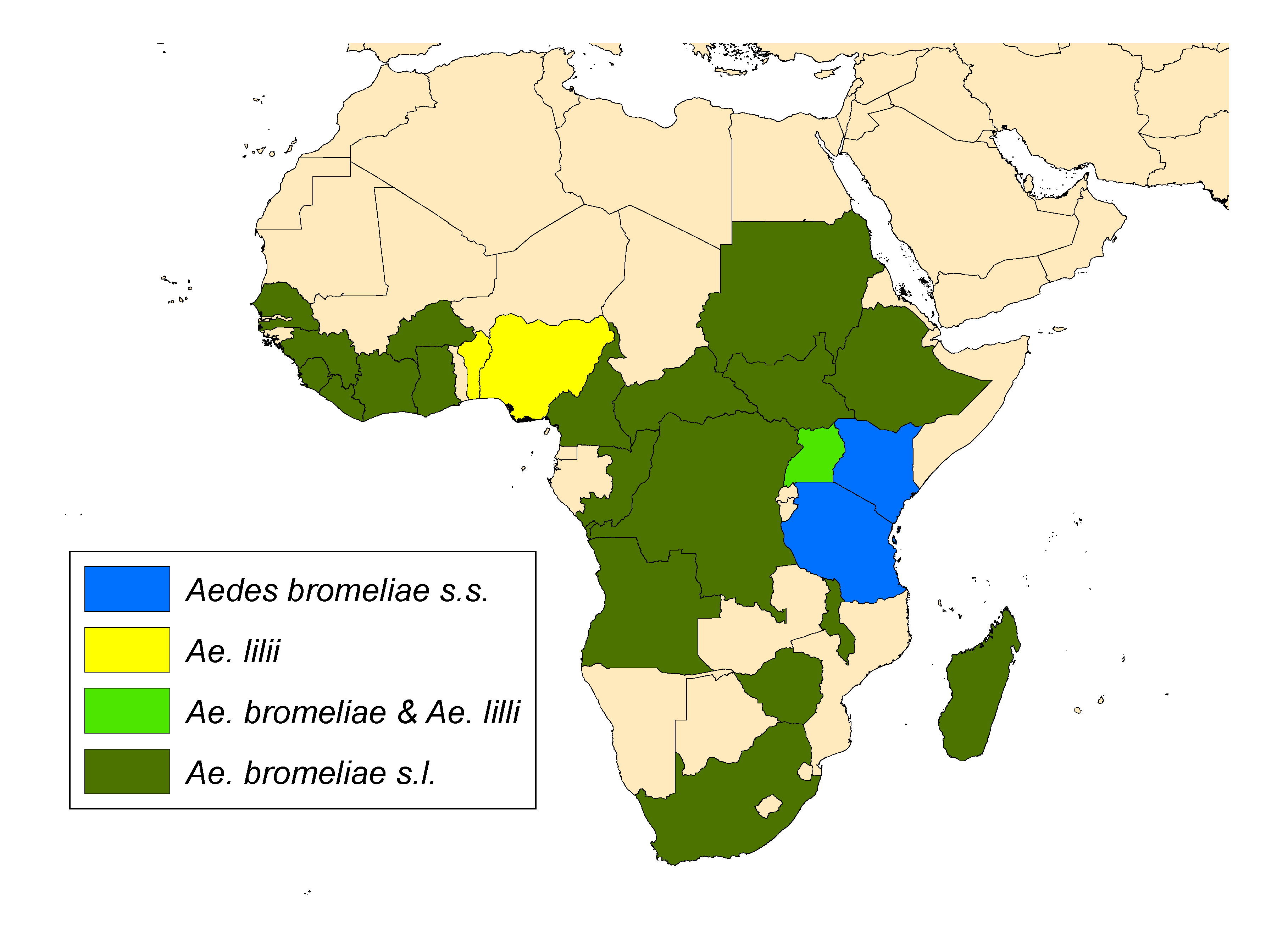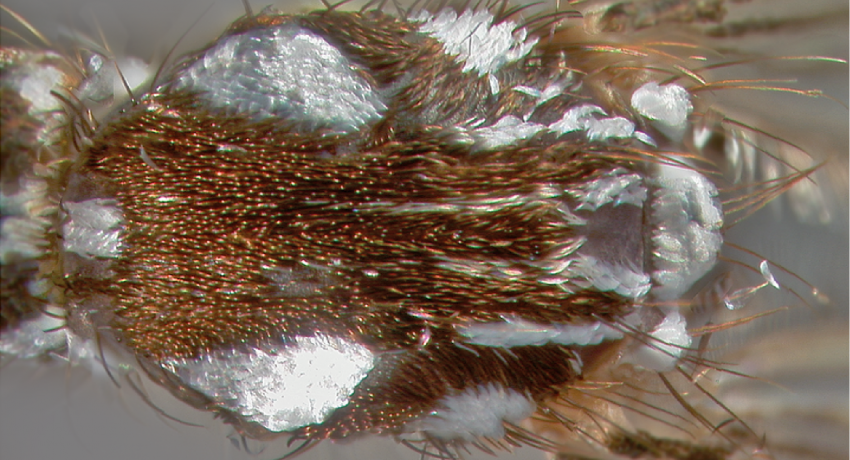AFROTROPICAL REGION
Etymology: not stated [pineapple (L): possibly refers to larvae found in pineapple bracts]
Aedes bromeliae belongs to the Simpsoni Group of the Aedes subgenus Stegomyia. It is one of three morphologically similar sister species belonging to the Simpsoni Complex, including Ae. simpsoni (Theobald), and Ae. lilii (Theobald). Molecular techniques are needed to reliably differentiate these species and have confirmed that Ae. bromeliae is the most widespread and abundant Simpsoni Complex taxa across most of central and eastern sub-Saharan Africa. Aedes lilii is more common in western Africa, and is the only member of the group found in the Republic of Benin, and Ae. simpsoni is restricted to southern Africa. Despite intensive surveys, only Ae. bromeliae was found in Tanzania, but in neighboring Uganda, Ae. bromeliae and Ae. lilii are found in sympatry.
Type locality: Kampala Swamp, Uganda
Type depository: Natural History Museum, London, England, United Kingdom (NHMUK)
DIAGNOSTIC CHARACTERS (Click photos to view; mouse over and click large photo to zoom in.)
ADULT (illustrated): Head: Proboscis entirely dark-scaled; palpus with white scales at apex; pedicel with lateral scales. Thorax: Scutum with submedian stripes; scutal fossa with patch of broad white scales; scutellum with broad white scales on lobes; lower proepisternal and mesepimeral scales present; paratergite with broad white scales; postspiracular area without scales; subspiracular area with broad white scales. Legs: Ta-I–III with only basal bands; Fe-III with apical white “knee” spot; Ta-III4 variable in color, where white band is present, always basal; Ta-III5 all or mostly white; Fe-II with apical “knee” spot and white spot on anterior surface; Ta-II2 with at least basal 0.5 white.
LARVA (not illustrated): Head: Seta 1-A very small, weakly developed; seta 4-C prominent, branched; seta 5-C single, at same level as 7-C; setae 4,6-C distinctly anterior to 7-C. Terminal segments: Comb scales in single row; four pairs of seta 4-X; precratal setae absent.
TAXONOMIC KEYS
Jupp 1996
Huang 2004
![]()
WRBU – Aedes – Afrotropical Region – Larva
Exemplar DNA sequences
Ae. bromeliae COI: KT998409–28, MF183226–58, KF135496–97
Ae. lilii COI: KT998389–408
BIONOMICS
Immatures
Female Ae. bromeliae are peri-domestic and closely associated with agricultural plots, where they lay their eggs in a variety of plant axils and containers. Immatures are most commonly found in water collections in leaf axils of food plants—pineapple, taro, banana—and in tree holes. Immatures are found in habitats in the forest floor (e.g., water collections in fallen palm spathes) to banana plant axils, up to 2 meters above the ground.
Adults
Aedes bromeliae readily bites man and monkeys that enter the plantations at ground levels. It is not thought to host-seek in the canopy. Aedes bromeliae is highly efficient vector of yellow fever, whereas Ae. lilii is zoophilic and of no biomedical importance. Introgression was noted between the taxa in sympatric populations in Uganda, leading scientists to fear that hybrid Ae. lilii would then feed on humans and become involved in the human yellow fever virus (YFV) cycle.
DISTRIBUTION NOTES
Angola, Benin, Burkina Faso, Cameroon, Central African Republic, Comoros, Congo, Côte d'Ivoire, Democratic Republic of the Congo, Ethiopia, Ghana, Guinea, Kenya, Liberia, Madagascar (includes Glorioso & Juan De Nova Is), Malawi, Nigeria, Republic of South Africa, Senegal, Sierra Leone, Sudan & South Sudan, Tanzania, Uganda, Zimbabwe.

WRBU VECTOR HAZARD REPORTS
None; View other WRBU Vector Hazard Reports
Available GIS Models
None
IMPORTANT REFERENCES (full citations below)
Theobald 1911a: 10 (M, F*; Stegomyia)
Huang 1979b: 226 (from synonym with simpsoni)
Huang 1986c (distribution, bionomics)
Jupp 1996 (M*, F*; key)
Huang 2004 (M*, F*; taxonomy, key to adults, distribution)
Bennett et al. 2015 (molecular taxonomy; bromeliae, lilii comparison)
CURRENT SYNONYMS
None
CITED REFERENCES
Bennett, K.L., Linton, Y.-M., Shija, F., Kaddumukasa, M., Djouaka, R., Misinzo, G., . . . Walton, C. (2015). Molecular differentiation of the African Yellow Fever vector Aedes bromeliae (Diptera: Culicidae) from its sympatric non-vector sister species, Aedes lilii. PloS Neglected Tropical Diseases, 9(12), e0004250.
Huang, Y.-M. (1979b). Aedes (Stegomyia) simpsoni complex in the Ethiopian region with lectotype designation for simpsoni (Theobald) (Diptera: Culicidae). Mosquito Systematics, 11(3), 221–234.
Huang, Y.-M. (1986c). Aedes (Stegomyia) bromeliae (Diptera: Culicidae), the yellow fever virus vector in east Africa. Journal of Medical Entomology, 23(2), 196–200.
Huang, Y.-M. (2004). The subgenus Stegomyia of Aedes in the Afrotropical Region with keys to the species (Diptera: Culicidae). Zootaxa, 700, 1–120.
Jupp, P.G. (1996). Mosquitoes of southern Africa. Culicinae and Toxorhynchitinae. Ekogilde Publishers, Hartebeespoort, South Africa, 156pp.
Theobald, F.V. (1911a). Uganda Culicidae including thirteen new species. Part I, 35 pp.
CITE THIS PAGE
Walter Reed Biosystematics Unit (Year). Aedes bromeliae species page. Walter Reed Biosystematics Unit Website, http://wrbu.si.edu/vectorspecies/mosquitoes/bromeliae, accessed on [date (e.g. 03 February 2020) when you last viewed the site].










































































































































































